
Syzygium paniculatum, the magenta lilly pilly or magenta cherry, is a species of flowering plant in the myrtle family Myrtaceae, native to New South Wales, Australia. A broad dense bushy rainforest tree, in cultivation it grows to a height of 15 m (49 ft) with a trunk diameter up to 35 cm (14 in). The largest known example is at Ourimbah Creek, 35 m (115 ft) metres tall. The leaves are 3–9 cm (1.2–3.5 in) long, opposite, simple and slightly obovate, tapering at the leaf base. They are dark glossy green above, and paler below. White flowers are produced in clusters. The edible fruit is usually magenta, but can be white, pink or purple.

Pouteria australis, also known by the synonym Planchonella australis, is a medium to tall rainforest tree of the family Sapotaceae native to Queensland and New South Wales, Australia. It is known by the common name black apple, wild plum, yellow buttonwood, black plum and yellow bulletwood.

Glochidion ferdinandi, with common names that include cheese tree, is a species of small to medium–sized trees, constituting part of the plant family Phyllanthaceae. They grow naturally across eastern Australia, from south–eastern New South Wales northwards to northern and inland Queensland, in rainforests and humid eucalypt forests. Frugivorous birds such as pigeons, figbirds and parrots consume its fruit.

Telopea mongaensis, commonly known as the Monga waratah or Braidwood waratah, is a shrub or small tree in the family Proteaceae. Endemic to Australia, it grows at high altitude in south eastern New South Wales, where it is often seen in moist areas at the edge of rainforest or by streams in eucalyptus forests. Growing to 6 m (20 ft) high, it has narrow green leaves 4–18 cm (1.6–7.1 in) in length, and 0.5–2 cm (0.20–0.79 in) wide. In spring bears many red flowerheads, each made up of 28 to 65 individual flowers.

Telopea oreades, commonly known as the Gippsland-, mountain- or Victorian waratah, is a large shrub or small tree in the family Proteaceae. Native to southeastern Australia, it is found in wet sclerophyll forest and rainforest on rich acidic soils high in organic matter. No subspecies are recognised, though a northern isolated population hybridises extensively with the Braidwood waratah (T. mongaensis). Reaching a height of up to 19 metres, T. oreades grows with a single trunk and erect habit. It has dark green leaves with prominent veins that are 11–28 centimetres (4.3–11 in) long and 1.5–6 cm (0.6–2.4 in) wide. The red flower heads, known as inflorescences, appear in late spring. Each is composed of up to 60 individual flowers.
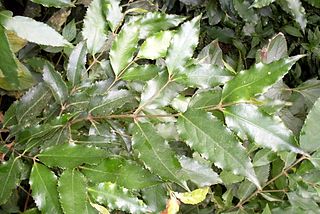
Daphnandra is a genus of shrubs and trees in the family Atherospermataceae, or formerly Monimiaceae. The genus is endemic to Australia.

Diospyros mabacea, the red-fruited ebony is a rare rainforest tree in the ebony or persimmon family growing in north eastern New South Wales. Listed as endangered by extinction.

Clerodendrum tomentosum, known as the downy chance, hairy lolly bush, hairy clairy or hairy clerodendrum is a shrub or small tree occurring in eastern and northern Australia. Distributed from Batemans Bay in southern coastal New South Wales, Queensland, Northern Territory, Western Australia, and New Guinea.

Daphnandra apatela, the socketwood, light yellowwood or canary socketwood is a common rainforest tree in eastern Australia. It grows in the more fertile alluvial soils and basaltic soils. Distributed from the Watagan Mountains in New South Wales to Miriam Vale near Gladstone in Queensland.
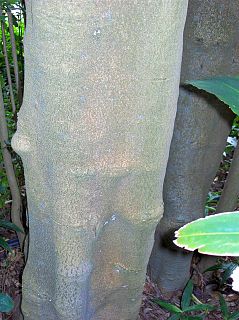
Daphnandra micrantha, the socketwood or Manning River socketwood is a rainforest tree in eastern Australia. It grows near streams in various types of rainforest. Restricted to the Manning River and Hastings River valleys of northern eastern New South Wales. Also seen in ecotone areas dominated by brush box and tallowwood.
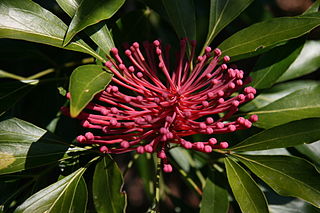
Alloxylon pinnatum, known as Dorrigo waratah, is a tree of the family Proteaceae found in warm-temperate rainforest of south-east Queensland and northern New South Wales in eastern Australia. It has shiny green leaves that are either pinnate (lobed) and up to 30 cm (12 in) long, or lanceolate (spear-shaped) and up to 15 cm (5.9 in) long. The prominent pinkish-red flower heads, known as inflorescences, appear in spring and summer; these are made up of 50 to 140 individual flowers arranged in corymb or raceme. These are followed by rectangular woody seed pods, which bear two rows of winged seeds.

Dysoxylum mollissimum subsp. molle, the red bean or Miva mahogany, is a rainforest tree in the family Meliaceae. It occurs in tropical, sub-tropical and littoral rainforests in eastern Australia, as far southwards as north-eastern New South Wales. Also occurs in Malesia and the south-western Pacific Islands. In Australia it is distributed from the Bellinger River in New South Wales in the south, to the wet tropics of north-eastern Queensland. The specific epithet mollissimum is from the Latin, meaning "very soft", describing the soft hairy leaflets. A signposted red bean tree may be seen near the car park of Victoria Park Nature Reserve in north-eastern New South Wales.
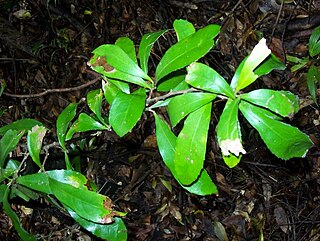
Helicia glabriflora is a species of rainforest shrubs or small trees occurring in eastern Australia. Common names include smooth or pale helicia, pale, leather or brown oak. They grow naturally in a variety of different rainforest types from the Illawarra, New South Wales to the Townsville area, Queensland. Of all the global diversity of approximately one hundred Helicia species, this one species naturally grows the furthest south, in the Minnamurra Rainforest and the Robertson area, Illawarra, New South Wales, there observed more on the relatively fertile basalt and alluvial soils.

Dysoxylum rufum is a rainforest tree in the family Meliaceae, found in eastern Australia. It occurs on a variety of different soils and rainforest types. From as far south as Bulahdelah, New South Wales to the McIlwraith Range in far north eastern Australia. The specific epithet rufum refers to the rusty red of the leaf, fruit and flower hairs of this species.

Archidendron muellerianum, the Veiny Lace Flower, or Small-flower Laceflower is a rainforest tree with a restricted range in eastern Australia. It is a rare plant, with a ROTAP rating of 3RCa.

Rhodamnia whiteana, known as the cliff malletwood or White's malletwood is a sub-tropical rainforest plant of eastern Australia.

Gossia fragrantissima, the sweet myrtle or small-leaved myrtle, is a shrub or small tree of eastern Australia. A plant with a ROTAP rating of 3EC-, endangered by extinction. Found in sub tropical rainforests near streams, from near Woodburn, New South Wales to Nambour in south eastern Queensland. It features fragrant flowers, hence the specific epithet fragrantissima. White flowers grow from October to February.

Alphitonia petriei, known as the white ash, is a rainforest tree in the family Rhamnaceae. It grows in eastern and northern Australia. Other common names include red ash, white-leaf, pink almond and pink ash. It was originally collected from the Johnston River near Kuranda, and named in 1925 by K.W. Braid. The authors gave it the species name petriei after W.R. Petrie, who alerted them to its distinctness.
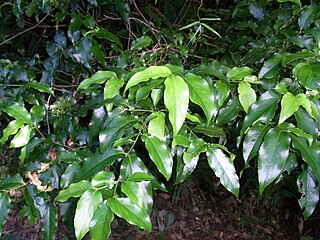
Daphnandra melasmena, commonly known as the socketwood, or black-leaved socketwood is a rainforest tree in eastern Australia. It grows on the more fertile basaltic soils, often associated with the White Booyong. Found from near Bowraville, New South Wales in the south to the Tweed Valley further north. A small to medium-sized tree growing to 20 metres tall with a stem diameter of 30 cm.

Lomatia arborescens, commonly known as smooth lomatia or tree lomatia, is a shrub or small tree that grows at high altitudes, in and near rainforests. It is found north from the Barrington Tops area in eastern Australia.



















